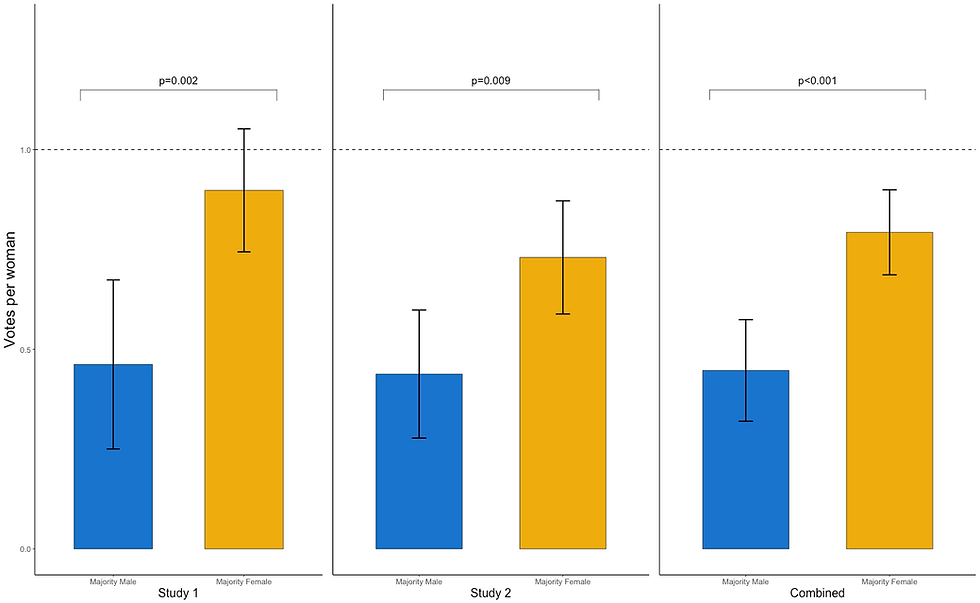New research on the causes of gender disparities at work
- Stephen O'Conell

- 25 sept 2023
- 4 Min. de lectura
In an era marked by halting progress towards greater gender equality, persistent disparities remain. In work environments, the gender earnings gap and the underrepresentation of women in influential settings remain pressing concerns. In Colombia, for example, recent legislation on parental leave and the discussions around the ratification of ILO convention 156 on workers with care responsibilities are taking place with a backdrop of women’s share of elected officials remaining below 20 percent, their share of the labor force around 41 percent, and Latin America in general lagging in women’s representation among corporate leadership. On the other hand, Colombia was recently ranked as the only Latin American country in the top 20 countries globally for female entrepreneurs.
A recent paper that my coauthors (Chris Karpowitz, @profkarpo, Jessica Preece, @jrpjrpjrp; and Olga Stoddard, @olgastoddard) have written aims to shed light on one of the potentially foundational contributors to gender gaps in labor markets and careers: whether and how women are seen as influential in collaborative work teams. In a recent paper joint with, we investigate the impact of changing gender composition and leadership on women's ability to contribute to discussions and decisions in collaborative work teams. We study this question in the context of the broad push by organizations to create diverse and inclusive teams, with questions arising about the effectiveness of such initiatives in traditionally male-dominated environments.
To study this question, we conducted two natural field experiments in the context of undergraduate academic work teams that investigate how group gender compositions shape women’s influence in deliberation and decision-making, and whether the identity of a team’s leader matters for their own or other women’s influence.
In the first experiment, we assigned subjects first to a five-person group that was to have either on woman and four men, or three women and two men. In the second experiment, we assigned participants into two-women/four-men or four-women/two-men teams. They then collaborated throughout a four-month-long period in weekly meetings on a series of assignments and exercises, and we recorded details of their interactions and importantly, subjective assessments of their group-mates performance.
We were particularly interested in measuring influence, and one of our primary outcomes is a question asking each subject to rank their group members in terms of influence in group discussions and decisions. This question was asked at various points throughout the months of collaboration, both after specific activities and exercises and in terms of overall group influence. If influence is expressed and assessed independent of gender, then we would expect a proportionate share of influence “votes” to go to women regardless of the gender composition of the group they are in.
Perhaps unsurprisingly, we find that this is not the case: women in minority-female groups are assessed as disproportionately less influential than their peers in majority-female groups. This is broadly the case regardless of the measure of influence we use or the time period or exercise over which the assessment is made. Figure 1 from our paper is reproduced below, and conveys this result and the striking disproportionate disadvantage that women face in the perceptions of their influence among teammates in general, and particularly in minority-female groups.
Figure 1: Women´s Influence and Authority by Group Gender Composition

(a) Team-Bulding Task: Most Influential Votes

(b) Team-Bulding Task: Incentivized Spokesperson Votes

(c) Global Assessment: Most Influential Votes
Note: Figure reproduced from Figure 1 of Karpowitz, O’Connell, Preece, and Stoddard (2023).
Study 2 was designed with two purposes: as a replication test of Study 1, and to delve deeper into potential solutions to addressing the influence disparity experienced by women. For this latter purpose, we added an additional crossed experimental condition: whether an assigned group “leader” was female or male. (Note that there were no official or assigned group leaders in Study 1.) We found that assigning a female group leader reduces the disparity in influence assessments by one third to one half, and this happens in both majority-female and minority-female groups. We also find some evidence that assigning a male leader increases the vote penalty faced by women, particularly when men are in the minority. The Figure below conveys these results.
Figure 3: The Effects of formal Leadership on Women's Influence

(a) Perceived Team-Building Influence

(b) Team-Building Task Spokesperson Votes
Note: Figure reproduced from Figure 3 of Karpowitz, O’Connell, Preece, and Stoddard (2023).
Our paper contributes to an ongoing contemporary debate about gender diversity, representation, and leadership in the workforce. On the one hand, we show that the first women entering male-dominated environments are likely to experience substantial influence deficits. Moving them to teams with more women or to teams led by women can reduce these deficits substantially, although certainly not entirely – underscoring the scope and limitations of formal structures intended to promote women’s experience of equal treatment by colleagues. We believe this research holds relevance for all spaces where collective decision-making occurs. As societies endeavor to achieve genuine diversity and inclusivity, we confirm that intentional efforts to balance representation and create environments where diverse perspectives can lead to greater influence of historically excluded populations.

Stephen O´Connell
About the author
Stephen D. O’Connell is Associate Professor of Economics at Emory University, USA. He is an applied microeconomist studying social protection and inclusion at the intersection of labor and development economics and on topics of gender, employment, entrepreneurship, forced displacement, and social policy design. He can be reached at soconnell@emory.edu and is online occasionally as @steveoconnell1. He will be presenting the research discussed in this article at LACEA 2023 in Bogotá on Saturday, November 18th, 2023


Comentarios